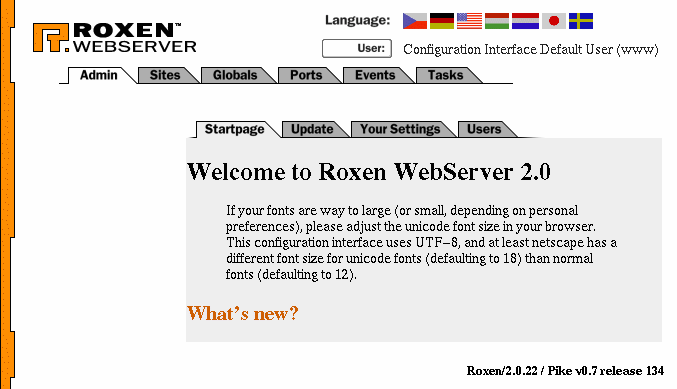|
© 2000 Roxen Internet Software Suggestions, Comments or Complaints manuals@roxen.com |
||
     |
||
InstallationInstallation
To install a Roxen server you first install the software, then connect to the web based administration interface and create the actual web or FTP sites. For each site you enable and configure the modules that are going to handle it. A basic web site only needs a small set of modules while a highly customized site that makes full usage of scripting and database need more. To make it simpler to get started there are predefined server templates that contain the necessary modules to get a certain type of web or ftp site up and running. By choosing a server template you don?t have to manually enable those modules and you get a set of modules that gives you a working site. If you already have a web site that you want to move to Roxen this shouldn?t pose much of a problem. The toughest part is usually to get all scripts to run, since there may be slight differences between different implementations of standards such as CGI, SSI or .htaccess. Some features of Roxen relies on code outside of Roxen to work. The Java support requires a Java 2.0 compliant virtual machine to be installed on the server. The database supports requires database connectivity libraries. Therefore it is harder to get these functions to work and it might be necessary to install software other than the Roxen server itself. Installing the softwareThe Roxen server consists of a Pike interpreter and the Roxen server itself. The software is installed either from a binary or a source package. Binary packages are precompiled for each operating system while the source package can be compiled on any operating system except Windows. Usually the binary packages are a lot faster and easier to install. But some libraries might differ from your system in which case you are left with compiling a source distribution. The last step of the software installation is setting a username and password and then starting the server so the administration interface becomes available. Administration interfaceThe bulk of the installation process is done through the administration interface. Here you create your sites and enable the modules you need. You can download additional software directly from the administration interface with the update client. SitesA Roxen server can handle any number of sites with their own modules. Usually you have at least two sites, one for the administration interface itself and another for your actual web site. Each site is bound to at least one URL. The URL is in turn handled by a port. The ports are created automatically and can be further configured on the Ports tab. Several sites may share the same port. This is always done for IP-less HTTP, when several sites share the same IP number. But it is even possible to have several Roxen sites on each web site. You could for example give the administration interface the URL http://my-sajt/admin/ if you don?t want to create an entire new web site for it. UpgradingThere are a number of major changes in the 2.0 release. However there are modules making it backwards compatible with Roxen Challenger 1.3. Old sites are supported with no changes to the site content. Unfortunately the way the configurations are stored has changed as well, so you have to configure your sites manually rather than only installing the new software. If you have a lot of sites it is possible to make a script that makes the bulk of the work. MigratingMoving an existing web site to a Roxen server should pose no major problems, if Roxen supports all scripts that are used on the site. Usually you only have to tell Roxen where the web site is located. If scripts are used you also need to enable modules to handle the scripts. |
|||
